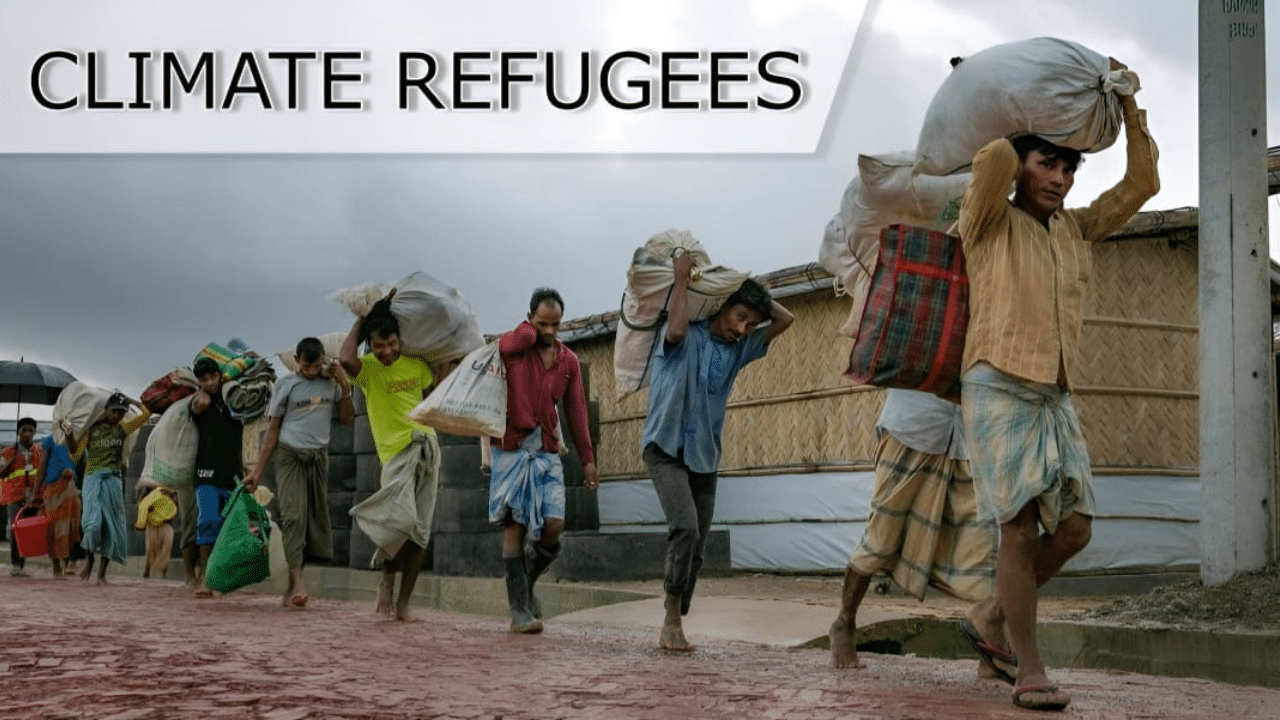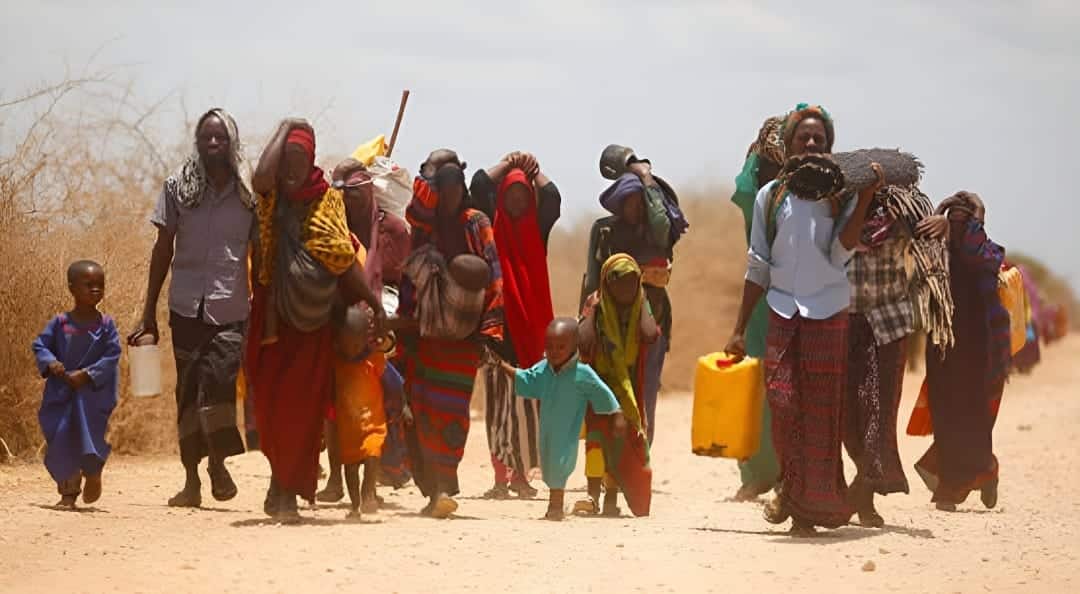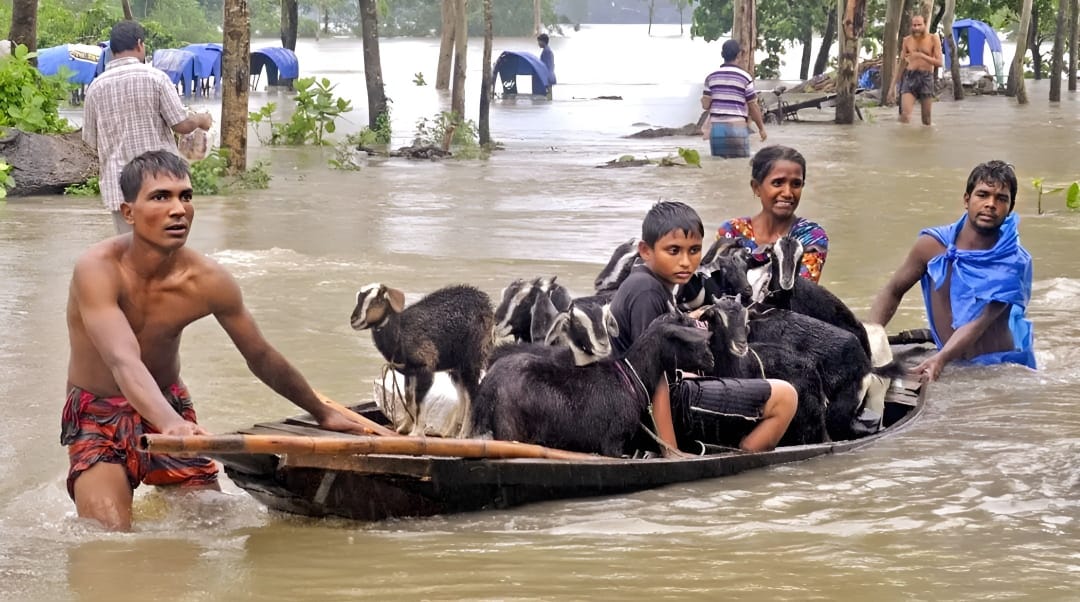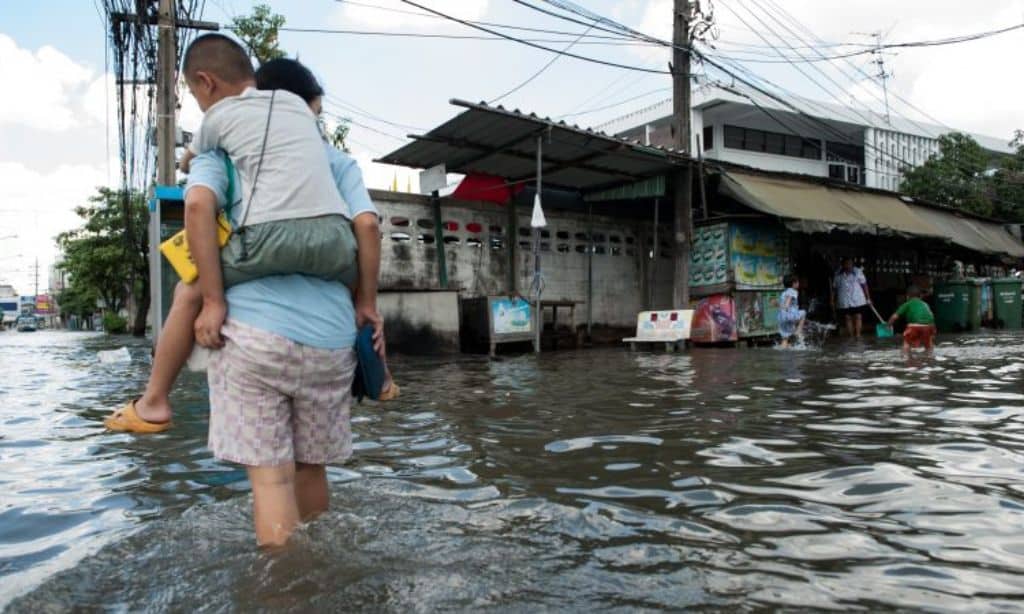The impacts of climate change are already being felt worldwide, as rising seas, droughts, floods, and other extreme weather events displace millions of people. As global temperatures continue to rise, even more, will be forced to leave their homes and communities in search of safety and livelihoods elsewhere. These displaced individuals are increasingly being referred to as “climate refugees” – people who have been uprooted from their homes, mainly against their will, due to the effects of climate change.
This complex humanitarian challenge raises important questions about how the international community should respond. What protections or support should be provided to climate refugees? What obligations do high-emitting countries bear toward impacted populations, considering their outsized contribution to the climate crisis? As climate impacts intensify, how can the displacement of vulnerable people be minimized?
This article will explore the plight of climate refugees, the root causes of their displacement, and policy considerations around this emerging global issue. With climate change accelerating, the number of climate refugees will likely continue to grow in the coming decades. Finding humane, just solutions is paramount.
Definition of Climate Refugees
Climate refugees, also known as climate or environmental migrants, refer to people forced to leave their homes due to the direct and indirect consequences of climate change. These individuals may be compelled to migrate due to factors like rising sea levels, extreme weather events such as floods or droughts, loss of agricultural land caused by desertification or soil erosion, increasing severity of disasters like storms and hurricanes, increased water scarcity, disruption in traditional livelihoods caused by ocean acidification, etc.
The scale of displacement is expected to increase significantly in the future, with up to 1.2 billion people being forcibly displaced by 2050, according To United Nations reports.
Climate refugees are often living in “hotspots” – regions that are particularly vulnerable when it comes to the effects of climate change.
Impact of climate change on displacement
[Video Credits @CBS News]
Climate change has become a major driver of displacement, with people having to leave their homes and communities because of the effects of climate-related events. This includes extreme weather events such as floods, droughts, typhoons, and hurricanes that can cause landslides and destruction of farms or fishing waters.
These disasters create food insecurity which forces people to migrate in search of jobs elsewhere. Climate-induced migration also occurs due to resource scarcity (due to rising sea levels) or desertification – an area becoming unusable for human habitation due to lack of water caused by drought and heatwaves– resulting in groups being permanently displaced from their land as they cannot find sufficient resources needed for survival.
Moreover, loss of livelihoods is another common climate-related problem leading to displacement where high temperatures destroy crops, leaving farmers unable to grow produce while fisheries are wiped out due to increasingly acidic oceans, further forcing individuals dependent on these sources away from home to seek other job opportunities.
The Humanitarian Crisis
Climate change is having a devastating effect on the physical safety and well-being of millions of individuals around the world, resulting in an unprecedented humanitarian crisis.
Here are some key statistics on climate refugees:
- Between 2008 and 2020, weather-related disasters displaced an average of 23.1 million people per year (Internal Displacement Monitoring Centre).
- Over 30 million people, on average, have been displaced by climate-fueled disasters annually since 2010 (Oxfam).
- Extreme weather disasters triggered 98.4 million displacements between 2008 and 2020. Storms and floods led to over 80% of disaster displacements (IDMC).
- Over 216 million people could be displaced by climate impacts by 2050 (World Bank).
- The regions most affected by displacement linked to weather extremes are East Asia and the Pacific, South Asia, and Sub-Saharan Africa.
- Bangladesh, China, India, and the Philippines accounted for over half of all disaster displacements between 2008 and 2020 (IDMC).
- Small island states will likely face disproportionate displacement risks and losses from climate change impacts like sea level rise.
- Climate change is considered a threat multiplier that can exacerbate existing social, economic, and political tensions that drive displacement.
- Only about 20,000 people per year have been granted official protection or resettlement as climate refugees between 2015 and 2020 (UNHCR).
The scale of the crisis
The scale of the climate refugee crisis is vast and escalating rapidly due to the impacts of climate change. Here’s an overview of the crisis:
| Situation | Statistics |
|---|---|
| Climate crisis as a humanitarian crisis | The climate crisis has far-reaching consequences, exacerbating existing humanitarian crises globally. |
| Displacement due to climate change | Climate change is causing increasing displacement and migration, leading to devastating consequences for affected populations. |
| Role of UNHCR | The UNHCR actively provides protection and assistance to those affected by climate change-related displacement. |
| The future scale of the crisis | By 2050, there could be as many as 1.2 billion climate refugees worldwide, highlighting the urgent need for immediate action. |
| The link between the global refugee crisis and climate change | The global refugee crisis is intrinsically linked to climate change, with the two issues amplifying each other’s impact. |
Table: The Statistics of Humanitarian Crisis
These figures underscore the urgent need for global action to tackle this growing humanitarian crisis. The scale of the crisis also emphasizes the necessity for increased adaptation finance and comprehensive strategies to support climate refugees and address the root causes of displacement.
Read More: Global Warming: How Climate Change is Affecting Life on Earth?
Challenges faced by climate refugees
Climate refugees face numerous challenges when fleeing their homes for safer havens. These include displacement, loss of livelihoods, limited access to resources, and vulnerability in climate “hotspots” where the impact of climate change is most severe.
Climate change has led to more frequent and extreme weather events such as droughts, floods, heat waves, and cyclones that are destroying entire communities. Fleeing these invisible boundaries due to natural disasters can bring increased suffering for displaced populations – leading to a deteriorating quality of life due to limited resources or access to basic services such as clean water or healthcare.
Furthermore, many countries are ill-prepared or lack sufficient infrastructure to support large influxes of displaced people. This further strains already strained government budgets forcing them into difficult situations needing assistance from other nations if they wish to successfully integrate those who were forcibly migrated by the effects of our warming planet permanently into society while not cutting out any funds from important programs such as education initiatives etc.
Human rights implications
Climate change is having a devastating impact on the human rights of displaced populations and refugees around the world. As shifted climate patterns leave vast areas uninhabitable, people are being forced to flee their home countries in search of safety and basic necessities they lack.
This mass displacement inherently puts pressure on governments that must cope with sudden influxes in population. Those fleeing their homelands are vulnerable to exploitation, abuse, discrimination, inadequate health care and sanitation services, as well as violence along migratory routes – all threats to their fundamental human rights.
These conditions can carry into refugee camps, making it even more difficult for those fleeing violence or eviction to access even basic services like medical attention, education, or employment opportunities – compounding already existing language barriers or negative stereotypes against certain religions or ethnic backgrounds.
Moreover, as resources become scarce due to rising temperatures and extreme weather events, communities increasingly compete over them, leading often competing ethnic groups or religious sects into conflict, which further degrades respect towards the diverse cultures these migrants may represent.
The Role of UNHCR
The United Nations High Commissioner for Refugees (UNHCR) plays a key role in supporting climate refugees worldwide and advocating for their rights.
Law and policy development
The United Nations High Commissioner for Refugees (UNHCR) has taken active steps to ensure the protection of climate refugees. The organization is involved in developing legal and policy approaches for climate change displacement and works to support governments in creating laws and policies at various levels related to climate change and displacement.
- Strengthening sensitivity of national laws towards environmental degradation or natural disasters;
- Creating separate government offices focused on humanitarian responses to natural disasters;
- Establishing new legal categories for those displaced by manmade or environmental catastrophes;
- Incorporating human rights law into existing domestic refugee policies;
- Formulating regional laws that ‘supersede’ municipal or international norms;
- Facilitating access to justice through local initiatives such as community courts.
- Building awareness among host communities to foster positive attitudes towards newcomers;
- Developing clear government policies that enable microenterprises owned by migrants or IDPs;
- Encouraging fair labor practices that are accessible to displaced persons;
- Offering tailored training and workshops that increase uptake of relevant knowledge among decision makers;
- Establishing transparent national identification systems enabling undocumented populations to access essential services, health care, education, etc.;
- Generating data collection tools to identify needs based on gender, age group, or other criteria.
Operational support
UNHCR provides operational support by working with states to develop legal and policy approaches for people affected by climate change displacement. They partner with governments and NGOs on capacity building, training, joint assessments, program design, feedback mechanisms, monitoring, and evaluation of programs targeting environmental refugees. Additionally, they focus on protecting and strengthening the resilience of displaced persons and stateless individuals in the face of a changing climate.
- Developing strategies that protect human rights and promote public participation in decisions related to planned or ongoing environmental interventions;
- Supporting vulnerable communities towards disaster-resilient programming;
- Helping with early warning systems for hazards such as cyclones or floods;
- Combining satellite data analysis in order to identify those at higher risk from potential displacement;
- Training protection officers so they can better understand how the environment plays a role when assessing refugee claims ;
- Implementing disaster risk reduction plans before extreme events occur so families are more prepared if needs arise due to climate disasters, plus establishing safe spaces during crises.
Environmental footprint
Climate refugees are highly vulnerable to the impacts of climate change, and their displacement also has an impact on the environment. The need to provide food, shelter, energy, and other forms of support for climate refugees strains natural resources in host countries or communities.
UNHCR estimates that 20-25 million trees are cut down in refugee situations yearly as people move into regions with acute natural resource shortages. In addition, conflict between host and displaced populations over scarce resources can further pressure already drained reserves.
The lack of infrastructure increases environmental degradation in surrounding areas, too, due to waste contamination and pollution from combustibles such as wood burning for heating purposes.
Sustainable solutions must be implemented to minimize the environmental footprint associated with hosting climate refugees; mitigation strategies such as renewable energy sources should be prioritized while supporting affected communities through adaptation practices that increase resilience against future disasters and may reduce resource shortages caused by displacement.
Read Also: AI May be a ‘More Urgent’ Threat than Climate Change, Says Geoffrey Hinton
How Climate Change Affects Refugees and IDPs
Climate change often exacerbates the plight of refugees and IDPs, leaving them more vulnerable to disasters, conflicts, and uncertain livelihoods. Read more to learn how climate change is reshaping the dynamics of forced displacement.
Increased vulnerability to natural disasters
Climate change is one of the leading causes of displacement due to its intensified natural disasters. Over the past decade, more people have been displaced by weather-related crises than by conflict and war, as temperatures rise across the world and extreme storms become more frequent and severe.
Climate refugees are particularly vulnerable when it comes to facing natural disasters like floods, hurricanes, or wildfires, which will increase in intensity with rising global temperatures.
Such communities often lack access to resources needed for recovery, such as education, housing, healthcare, etc., leading to further disruption of their lives. Those already refugee populations living in ‘climate change hotspots’ face an even higher risk of displacement due to increased exposure to flooding and other climate-related events.
For example, low-lying areas near coasts are at greater risk from sea level rise than those away from oceans or bodies of water; similarly, villages located on riverbanks could be easily flooded during heavy monsoons, which can prove devastating for local populations.
Scarce resources and conflicts over land
Climate change is causing prolonged droughts and increasing temperatures, leading to depleted resources in many world regions. This stress on natural resources has put pressure on communities that rely on land for subsistence farming, clean water, fuelwood, and other essential needs.
Furthermore, competition over limited resources has often led to conflicts between various groups vying for control or ownership of scarce natural assets. Such inter-group tensions can result in adversaries using violence or displacement as a way to gain access to these vital sources.
As a result, climate refugees are increasingly facing protection challenges due to dwindling supplies of food and water which create situations ripe for exploitation by those with power or influence.
More fundamentally, vulnerable populations living around affected areas have been disproportionately impacted by this resource scarcity and lack of basic services such as education and healthcare – making them more likely to face conflicts over land and become climate refugees themselves when pushed out by superior forces.
Loss of livelihoods
Climate change disproportionately affects the world’s most vulnerable populations, including refugees and IDPs. One of the major impacts is a decline in their livelihoods. As temperatures continue to rise, extreme weather events become increasingly more frequent and severe, putting strain on traditional economies like agriculture and fishing that are dependent on stable climates.
This leads to serious economic issues for refugee populations who rely heavily on these typical sources of income or social safety nets. These effects can result in loss of resources, such as crop failure due to droughts, destruction from flooding or landslides, reduction in land suitable for cultivation, decline in fish catch due to ocean acidification, and reduced access to potable water, among others.
Such changes translate into difficult working conditions with decreased yields as well as commercial losses, which further aggravate an already challenging situation for climate refugees living below the poverty lines.
Advocacy and Awareness
Significant attention is being given to raising awareness of climate refugees and building global support for their protection through policy and normative development, research, and studies, as well as media coverage and storytelling.
Policy and normative development
is important for addressing the challenges faced by climate refugees. It helps to develop and promote standards of protection that ensure those displaced due to climate change are recognized, respected, and provided with support services. Through advocacy efforts such as public campaigns, research studies, media coverage, and storytelling, awareness about the plight of climate refugees is increased, which contributes to increasing pressure on governments at national and international levels to develop improved policies or take action.
Research and studies
Research and studies play an essential role in understanding and addressing the needs of climate refugees. By analyzing data related to displacement, researchers can identify trends that help to inform policy decisions.
Researchers can also assess how climate change impacts migration patterns so that governments are better equipped to respond when those forced to flee their homes arrive at new destinations.
Furthermore, research helps advocate for meaningful actions by presenting evidence on the human rights implications of fleeing due to climate change-induced disasters or resource scarcity; this way, appropriate regulations, and frameworks are put into place to protect refugee populations’ dignity and safety.
Interdisciplinary approaches such as networks involving scholars from fields like public health, economics, anthropology, and climatology offer richer insights necessary for devising effective solutions.
Media coverage and storytelling
Storytelling is an essential method of creating awareness about pressing issues. Regarding the climate refugee crisis, media coverage and storytelling are critical in amplifying the voices of affected communities and prompting engagement from decision-makers and global citizens.
By telling powerful stories that expose the realities faced by those displaced by climate change, journalists can help break down preconceived notions about “the other” and foster understanding across ideological divides.
In addition to providing an effective platform for advocacy, media coverage can also provide a space for reflection on these difficult humanitarian crises—especially at a time when this issue continues to become increasingly relevant as more communities experience displacement due to extreme weather events connected with global warming.
News programs like CNN’s Earth Matters seek to raise awareness via reporting on environmental disasters alongside human interest stories featuring those affected or impacted by them.
Such initiatives demonstrate how personal narratives—accompanied by expert commentary from scientists, activists, academics, etc.—can be utilized in order to create both empathy amongst audiences as well as discussions around sustainable solutions such as relocating entire communities under risk of water contamination or coastal flooding due rising sea levels brought on by anthropogenic factors like greenhouse gas emissions.
Government Action and Global Response
Governments around the world are beginning to recognize the need for international cooperation, policy development, and operational support in order to manage the plight of climate refugees.
International cooperation and agreements
are essential to addressing the growing humanitarian crisis of climate refugees. This is due to the fact that tackling this issue transcends national boundaries – with more extreme weather events, sea level rise, and other effects crossing geographical regions.
As such, coordinated efforts are required from multiple countries and international organizations in order to implement meaningful solutions for those displaced by climate change. International agreements provide the legal frameworks necessary for providing protection and assistance and securing resources needed to address these issues.
They can also ensure that more effective strategies are implemented with regard to mitigating or adapting against risks posed by a changing climate, thereby protecting vulnerable people from displacement and harm resulting from it.
Efforts of specific countries (e.g., Japan)
Japan has made significant efforts to address the growing humanitarian crisis related to climate refugees. As a member of the G7 and chair of its Foreign Ministers’ Meeting in 2023, Japan expressed its commitment to collective action against global challenges, including climate change and pollution.
In addition, Hiroshima Leaders’ Meeting in 2021 called for commitments to achieve sustainable development goals and respond appropriately to global challenges such as the climate crisis.
Specifically, Japan is committed to dialogue with international organizations, UN Agencies such as UNHCR, and other countries on how best to use financial resources for health care systems, disaster response measures, or education infrastructure projects that support safe migration solutions or resource-saving Technologies.
The need for a comprehensive global response
The climate refugee crisis is one of the most urgent and pressing humanitarian crises of our time. It has been estimated that by 2045, the need for a comprehensive global response to this growing dilemma is expected to grow by more than 40 percent.
This comes as millions of refugees bear the strongest effects of climate change and must endure increasingly scarce resources and conflicts over land compounded with an overwhelming loss of livelihoods, water sources, stable homes, and economic opportunities.
In addition, their vulnerability to natural disasters increases due to displacement stemming from changes in weather patterns caused by climate change. Those affected are also denied basic human rights protections due to current laws that do not cover environmental migrants since they lack formal status or protection under international law as refugees – leaving them unprotected against exploitation and abuse, including difficulty accessing education or medical care as well as facing labor injustices while living abroad.
Global organizations such as UNHCR have worked diligently in attempting to improve legal measures applicable for environment-induced people movements; introduce mechanisms for improved refugee responses within countries’ asylum systems; provide relevant technical support towards robust evidence-based decision-making; mobilize public opinion worldwide through advocacy campaigns towards better awareness raising on environmentally induced migration issues.
Addressing Climate Injustice
The need to recognize the unequal burden on vulnerable communities and ensure equitable solutions has become increasingly urgent. Read more to understand how this critical issue requires immediate action to create a more just future for climate refugees.
The unequal burden on vulnerable communities
Climate change disproportionately impacts vulnerable communities, both in high-income countries as well as low and middle-income countries. For instance, the limited access to resources like clean energy sources or adaptation infrastructure that these communities typically lack due to poverty amplifies their exposure to climate-related shocks such as floods and heat waves.
In addition, climate change can lead to the disruption of livelihoods due to crop failure, declining water availability, and increased temperatures – all of which impact their already poor economic means even further.
Moreover, with global temperature rising at an unprecedented rate for the past decades, it is only going to become more difficult for those living in extreme poverty or facing certain forms of discrimination – such as women – to escape from a cycle of hardship brought onto them by environmental stressors weakening or affecting existing vulnerabilities.
Calls for climate justice and equitable solutions
Climate justice emphasizes addressing the primary causes and consequences of climate change. This involves tackling injustices at social, gender, economic, intergenerational, and environmental levels that put some communities at greater risk from climate impacts than others.
Climate justice calls for urgent action to reduce emissions while allowing those who least contributed to climate change to disproportionately bear its negative effects. Such equitable solutions could help mitigate loss and damages stemming from extreme weather events, rehabilitation efforts following disasters, displacement of vulnerable populations, scarcity of resources due to water insecurity, or conflicts over land access – issues faced by many climate refugees today.
For instance, when Cyclone Idai left entire villages without clean drinking water in Mozambique’s Sofala province last year, many women had to spend hours fetching water risking their safety in the process, as sexual harassment incidents are reported on such trips in this regionally impoverished area.
Sustainable Solutions
Supportive measures must be taken to ensure climate-resilient communities and the integration of climate refugees into host societies in order to protect them from further displacement.
Mitigation and adaptation strategies
Mitigation and adaptation strategies are essential for limiting the displacement of people due to climate change. Mitigation is a preventative measure meant to stabilize greenhouse gas levels in order to minimize human interference with Earth’s climate systems. Adaptation, on the other hand, is an ongoing process that involves increasing resilience against climate hazards. In terms of protecting and supporting climate refugees, these strategies can be divided into three main areas:
- Strengthened disaster risk reduction measures;
- Improved access to resources and services;
- Increased social cohesion within host communities for integration purposes.
Support for climate-resilient communities
Climate-resilient communities are those that have the ability to learn, adjust, and respond to extreme weather events caused by climate change. These communities can also anticipate potential hazards and prepare for disasters while continuing to pursue economic and social development goals in a sustainable manner.
To build such resilience, it is important for governments around the world to provide support for these vulnerable populations in adapting to the impacts of climate change. Such measures include increasing access to clean energy sources; providing resources for building sustainable infrastructure; creating insurance systems for loss/damage from natural disasters; introducing capacity-building programs; and offering financial aid/grants.
Integration of climate refugees into host communities
To ensure safe and sustainable lives for climate refugees, it is essential to focus on integrating displaced people into host communities. A variety of approaches are needed for a successful transition:
- Restoring ecosystems: Protecting and restoring degraded ecosystems is important for supporting the livelihoods of both refugees and local populations in affected areas.
- Creating economic opportunities: Countries hosting climate refugees should develop initiatives that create decent jobs, improve access to education and health services, and provide legal protections.
- Social cohesion: It is necessary to build strong networks between host communities and refugee populations in order to facilitate social integration processes while protecting cultural identities.
- Disaster risk reduction: Governments must incorporate disaster risk reduction measures when formulating policies related to resettlement schemes, relocation plans, or housing solutions for displaced people.
- Combatting discrimination: To support refugees’ inclusion into local societies more effectively, barriers due to racial bias or prejudice need to be addressed decisively by raising awareness campaigns at the community level among not only displacement support actors but also political leaders.
Urgency of Action
The global climate crisis is increasingly making people vulnerable and creating a humanitarian emergency. Therefore, we must take urgent action to protect and support climate refugees all over the world in order to build resilience and address the root causes of displacement.
The need for immediate action to protect and support climate refugees
is pressing. Climate change has caused widespread displacement, creating a severe humanitarian crisis and putting millions of lives at risk around the world. In order to protect climate refugees and mitigate the effects of forced migration, it is essential that international policymakers collaborate to develop legal frameworks, provide economic support for affected countries, share resources equitably, and ensure sustainable livelihoods for all displaced individuals.
Governments must recognize their obligations under international law and support the efforts of UNHCR in providing protection for those fleeing climate disasters while also responding quickly to address their immediate needs on an emergency basis.
Furthermore, resource allocation should be targeted towards enabling communities devastated by droughts or floods—as well as those facing potential ecological threats—to create infrastructure capable of better coping with shifting weather patterns.
Building resilience and addressing the root causes of displacement
Climate change is one of the biggest threats facing humanity. As temperatures rise, it leads to droughts, floods, and sea level rise; these events often force people from their homes, creating climate refugees who are seeking safety and survival in other places.
In order to protect those affected by climate-induced displacement, it’s essential that we focus not only on remedial actions but also on proactive measures that reduce risk factors, such as tackling poverty and inequality and promoting sustainable development.
It is thus important to build resilience using adaptation strategies that help communities become better prepared for future disasters caused by climate change. These strategies include changing agricultural practices, water conservation techniques, and emergency management plans – all of which support vulnerable populations to be able to manage better risks associated with extreme weather events or natural catastrophes.
Furthermore, addressing the root causes of displacement must form part of any lasting solution if we are to ensure that future generations don’t suffer the same fate as existing victims of global warming have done so far.
If governments do not take steps now through international cooperation agreements, global response mechanisms, and providing financial assistance for local development investments, then this mass migration crisis will only worsen over time.
Frequently Asked Questions (FAQs)
If you still have queries about the climate refugees, you can check the answers below.
1. What is a climate refugee?
A climate refugee is someone who has been forced to leave their home due to the effects of climate change, such as sea level rise, extreme weather events, desertification, loss of freshwater sources, or other environmental disasters.
2. Why are people becoming climate refugees?
People are becoming climate refugees due to environmental disasters caused by global warming and rising sea levels, which render communities uninhabitable or cause food shortages or decreased air quality leading to health issues.
3. How many people have become climate refugees?
It is estimated that over 25 million people around the world have been displaced from their homes due to the effects of climate change. This number continues to grow with each passing year as temperatures continue to rise and the impacts worsen across regions.
4. What countries are most affected by this crisis?
The countries most affected by this humanitarian crisis include Bangladesh (1 million displaced), India (6 million displaced), and Japan (7 million internally displaced). Other countries like Indonesia, Pakistan, and Ethiopia also experience significant population displacement due to changing conditions brought about by global warming-related events such as floods raising sea levels in coastal areas and forcing relocation inland.















































